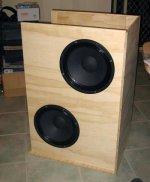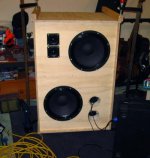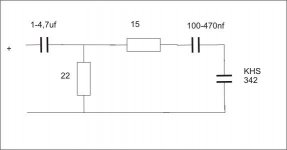Hi everyone.
I'm nearing completion of a project using peizo tweeters. The manufacturer recommends a series resistor to help protect the amp.
And yes, I know they should really have a proper crossover, but the project doesn't need to sound nice, the name of the game is cheap. 😀
The question I have is: does in matter what side of the tweeter the series resistor is? I mean do I have to have it between the amp + and the tweeter +, or can I put it on the - side.
From what I can remember of AC, shouldn't really matter. But something tells me it just might.
Any ideas?
Mark
I'm nearing completion of a project using peizo tweeters. The manufacturer recommends a series resistor to help protect the amp.
And yes, I know they should really have a proper crossover, but the project doesn't need to sound nice, the name of the game is cheap. 😀
The question I have is: does in matter what side of the tweeter the series resistor is? I mean do I have to have it between the amp + and the tweeter +, or can I put it on the - side.
From what I can remember of AC, shouldn't really matter. But something tells me it just might.
Any ideas?
Mark
Thanks for the quick reply, Sreten
I'd actually read all that. I actually USED the search function. 🙂
This is just a piezo chucked in a bass guitar cab, I can't be bothered doing a proper crossover, as long as it doesn't blow the amp. I don't really care as it's a bit of an experiment.
But the info in the wiki doesn't seem to address the specific question of whether an inline resistor needs to be on the positive side, or if the negative side is ok.
I'd appreciate any help, I know it might seem like a strange question. It's just to do with the wiring layout, It'd be more convenient to put it on the negative side if it won't make any difference.
Thanks,
Mark
I'd actually read all that. I actually USED the search function. 🙂
This is just a piezo chucked in a bass guitar cab, I can't be bothered doing a proper crossover, as long as it doesn't blow the amp. I don't really care as it's a bit of an experiment.
But the info in the wiki doesn't seem to address the specific question of whether an inline resistor needs to be on the positive side, or if the negative side is ok.
I'd appreciate any help, I know it might seem like a strange question. It's just to do with the wiring layout, It'd be more convenient to put it on the negative side if it won't make any difference.
Thanks,
Mark
I believe that it is same, resistor on + or -. Looking from amps view it is series connection of one resistor and cap.
Thanks geminni,
Yeah, that makes sense to me. BUT... I just have this lingering feeling it might not be quite right.
Maybe it's because on every crossover I remember seeing, all the components were on the + side (from the amp's positive).
Be good to get a definitive answer, I'd rather not find out by sending the amp into oscillation or something
cheers.
Mark
Yeah, that makes sense to me. BUT... I just have this lingering feeling it might not be quite right.
Maybe it's because on every crossover I remember seeing, all the components were on the + side (from the amp's positive).
Be good to get a definitive answer, I'd rather not find out by sending the amp into oscillation or something

cheers.
Mark
Hi,
whilst it is traditional to draw crossovers all relative to the negative
rail, in reality it does not matter which way round you do it, either
rail can be used, or to confuse people, both at the same time.
The Wiki contains important information on controlling piezo nasties.
For a bass cab I think the piezo mid drivers + horn might work best.
http://www.wle-shop.co.uk/modules/shop/view.asp?catid=79&Prodcode=902.490
http://www.wle-shop.co.uk/modules/shop/view.asp?catid=79&Prodcode=902.388
130 x 385 x 155mm
🙂/sreten.
whilst it is traditional to draw crossovers all relative to the negative
rail, in reality it does not matter which way round you do it, either
rail can be used, or to confuse people, both at the same time.
The Wiki contains important information on controlling piezo nasties.
For a bass cab I think the piezo mid drivers + horn might work best.
http://www.wle-shop.co.uk/modules/shop/view.asp?catid=79&Prodcode=902.490
An externally hosted image should be here but it was not working when we last tested it.
http://www.wle-shop.co.uk/modules/shop/view.asp?catid=79&Prodcode=902.388
An externally hosted image should be here but it was not working when we last tested it.
130 x 385 x 155mm
🙂/sreten.
Thanks again Sreten.
Yeah, I know they will sound a bit nasty, but I already had them. The plan is to make them switchable so I can add a bit more top end "sparkle". 😀
Or not...
If my ears feel like they're gonna bleed, I'll do a bigger cut out and add a cheap compression driver with a wave guide or horn.
Like I said, it's a cheap experiment!
Here's a couple of progress shots.
Cheers,
Mark
Yeah, I know they will sound a bit nasty, but I already had them. The plan is to make them switchable so I can add a bit more top end "sparkle". 😀
Or not...
If my ears feel like they're gonna bleed, I'll do a bigger cut out and add a cheap compression driver with a wave guide or horn.
Like I said, it's a cheap experiment!
Here's a couple of progress shots.
Cheers,
Mark
Attachments
It definitely does not matter which side the resistor goes.
I would strongly suggest adding a basic crossover - the tweeter will sound much, much better if you keep the big bass notes away from it.
The crossover needs two very cheap parts, a capacitor and a resistor (you still want the other series resistor, so you will end with two in total).
Connect one end of the cap to an input terminal. The other end of the cap goes to the junction of the two resistors. The series resistor that you already have goes to one side of the tweeter. The extra crossover resistor goes from the junction to the other wide of the tweeter
If you use one of the midrange horn devices, I would suggest a 1uF cap (50V or bigger rating) and 100Ohm crossover resistor - this will roll-off anything below about 1.6kHz. If you are using one of the small round tweeters, make that 0.33uF (again 50V or bigger), which will roll off below 5kHz. Any old cap will do, except for a polarised electrolytic.
Parts should leave lots of change from a dollar.
I would strongly suggest adding a basic crossover - the tweeter will sound much, much better if you keep the big bass notes away from it.
The crossover needs two very cheap parts, a capacitor and a resistor (you still want the other series resistor, so you will end with two in total).
Connect one end of the cap to an input terminal. The other end of the cap goes to the junction of the two resistors. The series resistor that you already have goes to one side of the tweeter. The extra crossover resistor goes from the junction to the other wide of the tweeter
If you use one of the midrange horn devices, I would suggest a 1uF cap (50V or bigger rating) and 100Ohm crossover resistor - this will roll-off anything below about 1.6kHz. If you are using one of the small round tweeters, make that 0.33uF (again 50V or bigger), which will roll off below 5kHz. Any old cap will do, except for a polarised electrolytic.
Parts should leave lots of change from a dollar.
Here is the schematic for piezo crossover. Firs C and 22R are high pass filter. 15R is your resistor which you wanted to put. The C2 (100-470nf) is for lovering piezo if it is louder then bass. That KHS342 ignore, that is some no-name brand piezo.
All resistors have to be at least 10W, i put 17W.
All resistors have to be at least 10W, i put 17W.
Attachments
+1 on Gemini's reply except:-
1/ He possibly should have stressed that Piezo crossovers are different to the usual variety, so don't be tempted to mount one. Gemini's advice is right on.
2/ I did exactly this to my Peavey TNT130. I couldn't detect any difference - except some hiss. I did manage to drop my power drill during the work though. - right through the driver!
3/ If you reach the stage that you are looking for this kind of improvement, you are at the stage where you need to go to talkbass.com and research a good DI box - because you will be playing through a sound reinforcement rig. You cab is now a personal monitor.
Don't get me wrong. Its worth experimenting, and I'm not trying to put you off learning. You need this knowledge to put cheap sound guys in their place. I'm trying to learn too. Currently its occurring to me that I have spent 5 days trying to fix a £60 amp and 5 days NOT playing bass!
1/ He possibly should have stressed that Piezo crossovers are different to the usual variety, so don't be tempted to mount one. Gemini's advice is right on.
2/ I did exactly this to my Peavey TNT130. I couldn't detect any difference - except some hiss. I did manage to drop my power drill during the work though. - right through the driver!
3/ If you reach the stage that you are looking for this kind of improvement, you are at the stage where you need to go to talkbass.com and research a good DI box - because you will be playing through a sound reinforcement rig. You cab is now a personal monitor.
Don't get me wrong. Its worth experimenting, and I'm not trying to put you off learning. You need this knowledge to put cheap sound guys in their place. I'm trying to learn too. Currently its occurring to me that I have spent 5 days trying to fix a £60 amp and 5 days NOT playing bass!
Thanks guys, I only have one more question.
With two tweeters, series or parallel?
And how much would I need to change the crossover?
Oops, guess that's two questions.
Cheers,
Mark
With two tweeters, series or parallel?
And how much would I need to change the crossover?
Oops, guess that's two questions.
Cheers,
Mark
Try connecting piezos parallel and listen if they are louder then bass drivers. If they are louder then you have to lower them with cap connected in series with piezos. That cap is on schematic marked with 100-470nf. With 100nf they will be quieter then with 470nf. If you have to use this cap it has to be MKT, MKP, type. Don't use ceramic (those round yellow-orange colored one)
To recap all this: In the schematic the most important elements to use are first cap and R, like i have mentioned previously, it is high pass filter and it uses to prevent damage of piezos. Like it's name say it passes high frequencies to piezo so less voltage will go to piezo.
You can connect piezo directly without filter but it will not last long if used with loud volume 🙂
Also i need to ask you why do you need pizeo for bas amplifier?
To recap all this: In the schematic the most important elements to use are first cap and R, like i have mentioned previously, it is high pass filter and it uses to prevent damage of piezos. Like it's name say it passes high frequencies to piezo so less voltage will go to piezo.
You can connect piezo directly without filter but it will not last long if used with loud volume 🙂
Also i need to ask you why do you need pizeo for bas amplifier?

Also i need to ask you why do you need pizeo for bas amplifier?
Because most 10", 12" and 15" drivers don't go as high as a piezo tweeter !¨
Regards
Charles
Well, i know that fact but i don't understand why putting piezo which is 5Khz and up? Bas guitar does not has that high frequencies.
Having piezo has a point if the speaker will be used also as full range, like for keyboard or microphones.
Having piezo has a point if the speaker will be used also as full range, like for keyboard or microphones.
Bas guitar does not has that high frequencies.
That is a rumour IMHO.
Regards
Charles
Hi geminni.
If you look around, you'll find a lot of bass cabs have tweeters these days. It's true that a bass guitar will not produce a fundamental note up around the 4khz area, but a lot of the tone comes from the harmonics, which actually go quite high, especially with some styles of playing.
The tweeters will be switchable, as I'd like to have the option of extending out the high frequency if I want.
That's the plan anyway. For tweeters I had lying around and a couple of bucks parts, I reckon why not?
😎
Cheers,
Mark
If you look around, you'll find a lot of bass cabs have tweeters these days. It's true that a bass guitar will not produce a fundamental note up around the 4khz area, but a lot of the tone comes from the harmonics, which actually go quite high, especially with some styles of playing.
The tweeters will be switchable, as I'd like to have the option of extending out the high frequency if I want.
That's the plan anyway. For tweeters I had lying around and a couple of bucks parts, I reckon why not?
😎
Cheers,
Mark
- Status
- Not open for further replies.
- Home
- Loudspeakers
- Multi-Way
- Quick piezo tweeter question



